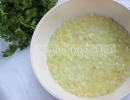Presentation on the topic "positive relationships between organisms." Positive relationships - symbiosis There are direct and indirect connections between organisms, what is their essence
Slide 2
Symbiosis concept
Symbiosis is cohabitation, a form of relationship in which both partners or one of them benefits from the other. There are several forms of mutually beneficial cohabitation of living organisms.
Slide 3
Cooperation
- Cooperation - the usefulness of the coexistence of organisms is obvious, but their connection is not necessary.
- The cohabitation of hermit crabs with soft coral polyps - anemones - is well known. Cancer settles in an empty mollusk shell and carries it along with the polyp.
Slide 4
Such cohabitation is mutually beneficial: moving along the bottom, the crayfish increases the space used by the anemone to catch prey, part of which, affected by the stinging cells of the sea anemone, falls to the bottom and is eaten by the crayfish.
Slide 8
They go into the crocodile's mouth and clean it.
Slide 10
Mutualism
- Mutualism is a form of mutually beneficial cohabitation, when the presence of a partner becomes a prerequisite for the existence of each of them
- One of the most famous examples of such relationships is lichens, which are cohabitations of a fungus and an algae. In lichen, fungal hyphae, entwining cells and threads of algae, form special suction processes that penetrate the cells. Through them, the fungus receives photosynthesis products formed by algae. The algae extracts water and mineral salts from the hyphae of the fungus.
rice. Cetraria centrifuga
Slide 11
Typical mutualism
- Typical mutualism - the relationship between termites and flagellated protozoa living in the intestines
- Termites eat wood, but they do not have digestive enzymes or cellulose. Flagellates produce such enzymes and convert fiber into simple sugars.
Slide 12
Without protozoa - symbionts - termites die of starvation. The flagellates themselves, in addition to a favorable climate, receive food and conditions for reproduction in the intestines of termites. Intestinal symbionts involved in the processing of rough plant feed are found in many animals: ruminants, rodents, and borers.
Slide 13
Example mutually beneficial relationships The coexistence of so-called nodule bacteria and leguminous plants (peas, beans, soybeans, clover, alfalfa, vetch, white acacia, groundnuts or peanuts) serves.
Slide 14
Nodules on soybean roots
These bacteria, capable of absorbing nitrogen from the air and converting it into ammonia and then into amino acids, settle in the roots of plants. The presence of bacteria causes the growth of root tissues and the formation of thickenings - nodules.
Slide 15
Cohabitation of nodule bacteria and leguminous plants
Plants in symbiosis with nitrogen-fixing bacteria can grow in soils poor in nitrogen and enrich the soil with it. That is why legumes - clover, alfalfa, vetch - are introduced into crop rotations as precursors for other crops.
Slide 16
On the roots of birch, pine, oak, spruce, as well as orchids, heathers, lingonberries and many perennial grasses, the mycelium of the fungus forms a thick layer.
Slide 17
Mushroom hyphae
Root hairs on roots higher plants At the same time, they do not develop, and water and mineral salts are absorbed with the help of the fungus.
Slide 18
Mycorrhiza - coexistence of a fungus with the roots of higher plants
The mycelium of the fungus even penetrates into the root, receiving carbohydrates from the partner plant and delivering water and mineral salts to it. Trees with mycorrhiza grow much better than without it.
Slide 19
Some species of ants feed on the sugary excrement of aphids and protect them from predators, in a word - “graze”.
Slide 21
Freeloading
Freeloading can take different shapes. For example, hyenas pick up the remains of prey left uneaten by lions.
Slide 22
Tenancy
An example of the transition of parasites into closer relationships between species are the sticky fish that live in tropical and subtropical seas. Their anterior dorsal fin is transformed into a sucker. The biological meaning of the attachment of sticks is to facilitate the movement and settlement of these fish.
Co-evolution
Close contact of species during symbiosis causes their joint evolution. An example of this is the mutual adaptations that have evolved between flowering plants and their pollinators.
Slide 29
Literature
- Zakharov V.B. General biology: Textbook. For 10-11 grades. general education Institutions/ V. B. Zakharov, S. G. Mamontov, N. I. Sonin. – 7th ed., stereotype. – M.: Bustard, 2004.
View all slides
“Communities of Water” - Crustaceans. In the ocean: 8. Natural history, 5th grade. Barnacle. 5. Pisces. 7. 3. Flying fish. Life in the seas and oceans. Nekton are active swimmers. Air bubble. How to stay on the surface of the water? 2. 4. Community of the water column. Portuguese man of war and a sailboat. Raymen. Water strider. Crab. Surface water community.
“Organism and habitat” - Give your examples negative influence humans to living organisms. Habitat and environmental factors, affecting living organisms. Sad story. Habitat – the most favorable environmental conditions. And on the other natural area? Biotic (Other living organisms). Soil environment.
"Abiotic factors" - Temperature. Cold-blooded organisms (invertebrates and many vertebrates). Main abiotic factors. Warm-blooded organisms (birds and mammals). Abiotic environmental factors. Humidity. Light. Optimal temperature regime for organisms from 15 to 30 degrees However, .... Adaptations are available. Plants: drought-resistant - moisture-loving and aquatic Animals: aquatic - there is enough water in food.
“Organism and environmental factors” - Abiotic factors 1mainly act on organisms regardless of population density. It has been established that the compressibility of some isopods and euphausiids is 15-40% lower than that of water. The distribution of aquatic organisms at different depths is associated not only with water pressure, but also with many other factors.
“Soil habitat” - What kind of environments do you think the insects whose legs are shown here live in? Plant roots. Short fur (for less friction with the soil). The mycelium of mushrooms is also located here, secreting mucus (promotes movement in the soil). The crab lives in an aquatic environment, while the rest live in a land-air environment. No.
“Lesson Soil” - We looked up at the sun, And the rays warmed us all. What is the main part of the soil? - Podzolic; - black soil. Water; air; salt. Fertility; water absorption. Sand; clay; humus. Humus; sand; clay. Leaves. The top fertile layer of the earth. Examination homework. Is everyone watching carefully? E.
There are a total of 34 presentations in the topic
1 slide

2 slide
Symbiosis is cohabitation, a form of relationship in which both partners or one of them benefits from the other. There are several forms of mutually beneficial cohabitation of living organisms (Zakharov V. B. General biology: Textbook for 10-11 grades of general educational institutions / V. B. Zakharov, S. G. Mamontov, N. I. Sonin. - 7th ed., stereotype. - M.: Bustard, 2004).

3 slide
Cooperation - the usefulness of the coexistence of organisms is obvious, but their connection is not necessary. The cohabitation of hermit crabs with soft coral polyps - sea anemones is well known. Cancer settles in an empty mollusk shell and carries it along with the polyp.

4 slide
Cooperation Such cohabitation is mutually beneficial: moving along the bottom, the crayfish increases the space used by the anemone to catch prey, part of which, affected by the stinging cells of the sea anemone, falls to the bottom and is eaten by the crayfish.



8 slide
Some birds also lead a similar lifestyle. They go into the crocodile's mouth and clean it


10 slide
Mutualism is a form of mutually beneficial cohabitation, when the presence of a partner becomes a prerequisite for the existence of each of them. One of the most famous examples of such relationships is lichens, which are the cohabitation of a fungus and algae. In lichen, fungal hyphae, entwining cells and threads of algae, form special suction processes that penetrate the cells. Through them, the fungus receives photosynthesis products formed by algae. The algae extracts water and mineral salts from the hyphae of the fungus. Cetraria centrifuga

11 slide
Typical mutualism is the relationship between termites and flagellated protozoa that live in the intestines. Termites feed on wood, but they do not have digestive enzymes or cellulose. Flagellates produce such enzymes and convert fiber into simple sugars.

12 slide
Without protozoa - symbionts - termites die of starvation. The flagellates themselves, in addition to a favorable climate, receive food and conditions for reproduction in the intestines of termites. Intestinal symbionts involved in the processing of rough plant feed are found in many animals: ruminants, rodents, and borers.

Slide 13
Cohabitation of nodule bacteria and leguminous plants An example of a mutually beneficial relationship is the cohabitation of so-called nodule bacteria and legume plants (peas, beans, soybeans, clover, alfalfa, vetch, black acacia, groundnuts or peanuts).

Slide 14
Nodules on soybean roots These bacteria, capable of absorbing nitrogen from the air and converting it into ammonia and then into amino acids, settle in the roots of plants. The presence of bacteria causes the growth of root tissues and the formation of thickenings - nodules.

15 slide
Cohabitation of nodule bacteria and leguminous plants Plants in symbiosis with nitrogen-fixing bacteria can grow on soils poor in nitrogen and enrich the soil with it. That is why legumes - clover, alfalfa, vetch - are introduced into crop rotations as precursors for other crops.

16 slide
Mycorrhiza is the cohabitation of a fungus with the roots of higher plants. On the roots of birch, pine, oak, spruce, as well as orchids, heathers, lingonberries and many perennial grasses, the mycelium of the fungus forms a thick layer.

Slide 17
Fungal hyphae Root hairs on the roots of higher plants do not develop, and water and mineral salts are absorbed with the help of the fungus.

18 slide
Mycorrhiza - cohabitation of a fungus with the roots of higher plants. The mycelium of the fungus even penetrates into the root, receiving carbohydrates from the partner plant and delivering water and mineral salts to it. Trees with mycorrhiza grow much better than without it. Various types of mycorrhizae

Slide 19
Symbiosis Some species of ants feed on the sugary excrement of aphids and protect them from predators, in a word - “graze”.


21 slides
Freeloading Freeloading can take many forms. For example, hyenas pick up the remains of prey left uneaten by lions.

Symbiosis (Greek: “living together”) is a form of relationship in which both partners or one of them benefits from the other. There is a wide range of examples of mutually beneficial symbiosis (mutualism) found in nature. From stomach and intestinal bacteria, without which digestion would be impossible, to plants (an example is orchids, whose pollen can only be spread by one specific type of insect). Such relationships are always successful when they increase the chances of survival for both partners. The actions carried out during symbiosis or the substances produced are essential and irreplaceable for the partners. In a generalized sense, such symbiosis is an intermediate link between interaction and fusion. In a broader scientific understanding, symbiosis is any form of interaction between organisms different types, including parasitism (relationships beneficial to one but harmful to another symbiont). Mutually advantageous view symbiosis is called mutualism. Commensalism is a relationship that is beneficial to one symbiont, but indifferent to the other, and amensalism is a relationship that is harmful to one, but indifferent to the other. A type of symbiosis is endosymbiosis, when one of the partners lives inside the cell of the other. l Science of symbiosis sim biology. The foundations of the doctrine of mutual assistance (including symbiosis) in the second half of the 19th century were laid independently by Russian naturalists P. A. Kropotkin and K. F. Kessler, as well as the German scientist Heinrich Anton de Bary, who proposed the terms “symbiosis” and "mutualism".
Commensalism Depending on the nature of the relationship between commensal species, three types of commensalism are distinguished: the commensal is limited to using the food of an organism of another species (for example, the hermit crab lives in the convolutions of the shell ringworm from the genus Nereis, feeding on crayfish food remains); The commensal attaches itself to an organism of another species, which becomes the “host” (for example, a fish that sticks with its suction fin attaches to the skin of sharks, etc. large fish, moving with their help); commensal settles in internal organs host (for example, some flagellates live in the intestines of mammals). l An example of commensalism is legumes (for example, clover) and cereals growing together on soils poor in available nitrogen compounds, but rich in potassium and phosphorus compounds. Moreover, if the cereal does not suppress the legume, then it, in turn, provides it with an additional amount of available nitrogen. But such relationships can only continue as long as the soil is poor in nitrogen and the cereals cannot grow much. If, as a result of the growth of legumes and active work Nitrogen-fixing nodule bacteria accumulate in the soil a sufficient amount of nitrogen compounds available for plants; this type of relationship is replaced by competition. The result, as a rule, is the complete or partial displacement of less competitive legumes from the phytocenosis.

Another variant of commensalism: unilateral assistance of a “nanny” plant to another plant. Thus, birch or alder can be a nanny for spruce: they protect young spruce trees from direct sun rays, without what on open place the spruce cannot grow, and also protect the seedlings of young fir trees from being squeezed out of the soil by frost. This type of relationship is typical only for young spruce plants. As a rule, when a spruce tree reaches a certain age, it begins to behave like a very strong competitor and suppresses its nannies. l Shrubs from the families Lamiaceae and Asteraceae and South American cacti have the same relationships. Possessing a special type of photosynthesis (CAM photosynthesis), which occurs during the day with closed stomata, young cacti become very overheated and suffer from direct sunlight. Therefore, they can only develop in the shade under the protection of drought-resistant shrubs. There are also numerous examples of symbiosis that is beneficial for one species and does not bring any benefit or harm to another species. For example, the human intestine is inhabited by many types of bacteria, the presence of which is harmless to humans. Similarly, plants called bromeliads (which include pineapple, for example) live on tree branches but get their nutrients from the air. These plants use the tree for support without depriving it nutrients. Plants make their own nutrients rather than getting them from the air. Commensalism is a way of coexistence of two different species of living organisms, in which one population benefits from the relationship, while the other receives neither benefit nor harm (for example, silverfish and humans).

Symbiosis and Evolution In addition to the nucleus, eukaryotic cells have many isolated internal structures called organelles. Mitochondria, a single type of organelle, generate energy and are therefore considered the powerhouses of the cell. Mitochondria, like the nucleus, are surrounded by a double-layer membrane and contain DNA. On this basis, a theory of the emergence of eukaryotic cells as a result of symbiosis has been proposed. One of the cells absorbed the other, and then it turned out that together they cope better than separately. This is the endosymbiotic theory of evolution. This theory easily explains the existence of a two-layer membrane. The inner layer originates from the membrane of the absorbed cell, and the outer layer is part of the membrane of the absorbed cell, wrapped around the alien cell. It is also well understood that mitochondrial DNA is nothing more than remnants of the DNA of an alien cell. So, many organelles of a eukaryotic cell at the beginning of their existence were separate organisms, and about a billion years ago they joined forces to create a new type of cell. Therefore, our own bodies are an illustration of one of the oldest partnerships in nature. l It should also be remembered that symbiosis is not only the coexistence of different types of living organisms. At the dawn of evolution, symbiosis was the engine that brought unicellular organisms of the same species into one multicellular organism (colony) and became the basis for the diversity of modern flora and fauna.

Examples of symbioses Endophytes (symbiotic fungi or bacteria) live inside a plant, feed on its substances, releasing compounds that promote the growth of the host organism. Transport of plant seeds by animals that eat the fruit and excrete the undigested seeds in droppings elsewhere. l Insects/plants -Insect pollination of flowering plants, during which the insects feed on nectar. -Some plants, such as tobacco, attract insects that can protect them from other insects. -The so-called “devil's gardens”: Duroia hirsuta trees serve as homes for ants of the species Myrmelachista schumanni, which kill the green shoots of other tree species that appear in the vicinity, thereby allowing Duroia hirsuta to grow without competition.








